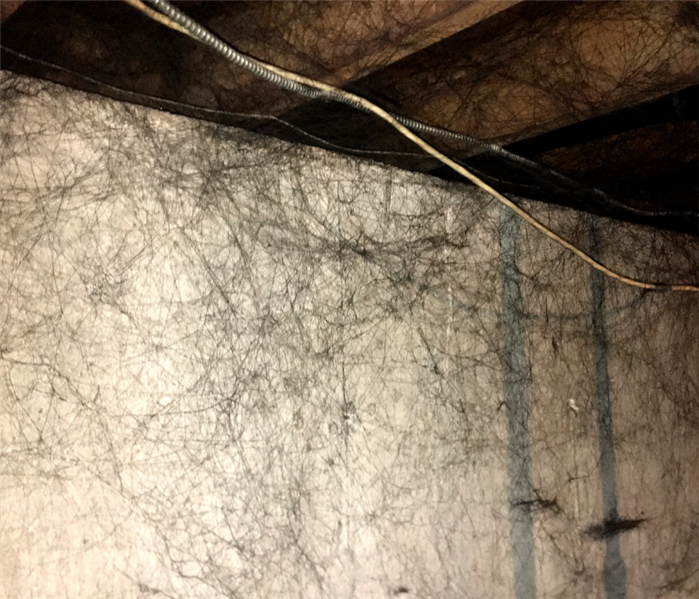What is a Furnace Puffback & How Do You Prevent Them?
10/7/2020 (Permalink)
Moving into the colder months, your heating system will be used around the clock. With regular maintenance by HVAC professionals, it should stay running smoothly all winter long. However, if your heating system isn't working correctly and the warning signs of a puffback are ignored, you may be left with a big sooty mess to cleanup.
A puffback is an explosion or misfire inside the burner chamber of your furnace or boiler. Note: Hot-air systems use furnaces while steam/hot water systems use boilers. This explosion sends smoke and soot throughout your home and requires professional puffback cleaning.
How Do Puffbacks Occur?
Puffbacks occur when a furnace or boiler doesn't properly ignite, allowing oil or gas vapors to build up in the combustion chamber. When the built up vapors do ignite, the excess amount of fuel in the chamber explodes or combusts. This then sends soot and smoke throughout the home's heating system, and can cover every surface.
Puffbacks can occur in one large misfire, or over time with smaller more constant misfires. When there is a large explosion inside your furnace, you may immediately notice black soot coming from your heating vents along with a smell immediately. But for the smaller explosions, you may not notice they are happening until soot becomes visible to your eye months later.
While they can occur in both oil and gas-fueled systems, misfires are more common in oil furnaces or boilers. This is because oil does not dissipate as easily and is more likely to build up in the heating system. Oil furnace puffbacks are also more damaging, as oil produces more soot and smoke than gas when it combusts.
What Actually Causes A Puffback?
Accumulation of fuel in the combustion chamber is what causes misfires, but what causes it to build up? There are a few reasons for fuel buildup in gas or oil burners:
- Leaks in the fuel supply line or at the combustion chamber
- Clogged or cracked oil fuel nozzles
- Clogged exhaust
- Clogged burner
These things can cause excess oil or gas to build up in the combustion chamber and lead to a misfire when it lights.
How Can You Prevent Them?
- Have your heating system serviced once a year. Even when you feel your systems are functioning correctly, it is still important to have them maintained. An HVAC professional can clear out any buildup or replace any parts that are causing the system to not perform at high efficiency.
- Install a carbon monoxide detector. When you have a puffback in your home, the carbon monoxide levels will rise. By installing a detector, you may be able to catch these misfires in their early stages before they cause extensive smoke or soot damage.
- Know the signs that your heating system is not working properly. When it isn't, it is likely to lead to a puffback. Signs include:
- Oil leaks
- Loud ignition
- Noise that continues after the system is off
- Odors
- Noticing soot buildup around your home
- Take action immediately. When you notice any of the above warning signs or suspect there is something going on with your heating system - take action quickly. On top of creating a sooty mess of your home, misfires can also be extremely dangerous as it is an explosion within your heating system.
What Should You Do If It Happens to You?
If a puffback happens to you, it can cause cause your entire building to be covered in soot and may even damage your entire heating system. Take the following steps to help return your property back to normal and prevent more damage:
- Immediately turn off the heating system to prevent further misfires, damage, and soot from spreading around the building.
- Evacuate the building if there is risk of a fire, a large amount of smoke, or the carbon monoxide detector is going off.
- Document everything for your insurance company if you plan on making a claim. While most puffbacks are cause by lack of maintenance, it doesn't hurt to see if it will be covered.
- Contact your HVAC repair technician. They will need to inspect and repair the system before it can be used again, and they will be able to identify the cause of the puffback to help ensure it doesn't happen again.
- Contact a professional puffback cleanup service. It is likely tempting to try and undertake the cleaning yourself, but without the right materials or knowledge you can actually end up smearing soot further into the walls. It is also likely that there is much more smoke and soot affecting your property than you can see with a naked eye. Soot cleanup companies will use dry chemical sponges to get soot off of walls and show you all areas which are actually affected.
Call SERVPRO of Branford/Shoreline For Puffback Cleanup - 800-734-3213
SERVPRO of Branford/Shoreline is a 24/7 damage restoration company specializing in fire, water, mold and COVID-19 services. Call us today to make any disaster "Like it never even happened."






 24/7 Emergency Service
24/7 Emergency Service
